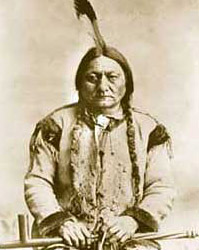The Last Frontier
In 1865 the frontier line generally followed the western limits of the states bordering the Mississippi River, but bulged outward beyond the eastern sections of Texas, Kansas, and Nebraska. Then, running north and south for nearly 1,600 kilometers, loomed huge mountain ranges, many rich in silver, gold, and other metals. To their west, plains and deserts stretched to the wooded coastal ranges and the Pacific Ocean. Apart from the settled districts in California and scattered outposts, the vast inland region was populated by Native Americans: among them the Great Plains tribes -- Sioux and Blackfoot, Pawnee and Cheyenne -- and the Indian cultures of the Southwest, including Apache, Navajo, and Hopi.

Sitting Bull, Sioux chief who led the last great battle of the Plains Indians against the U.S. Army, when his warriors defeated forces under the command of General George Custer at the Battle of Little Bighorn in 1876.
(Library of Congress)
A mere quarter-century later, virtually all this country had been carved into states and territories. Miners had ranged over the whole of the mountain country, tunneling into the earth, establishing little communities in Nevada, Montana, and Colorado. Cattle ranchers, taking advantage of the enormous grasslands, had laid claim to the huge expanse stretching from Texas to the upper Missouri River. Sheep herders had found their way to the valleys and mountain slopes. Farmers sank their plows into the plains and closed the gap between the East and West. By 1890 the frontier line had disappeared.
Settlement was spurred by the Homestead Act of 1862, which granted free farms of 64 hectares to citizens who would occupy and improve the land. Unfortunately for the would-be farmers, much of the Great Plains was suited more for cattle ranching than farming, and by 1880 nearly 22,400,000 hectares of "free" land were in the hands of cattlemen or the railroads.
In 1862 Congress also voted a charter to the Union Pacific Railroad, which pushed westward from Council Bluffs, Iowa, using mostly the labor of ex-soldiers and Irish immigrants. At the same time, the Central Pacific Railroad began to build eastward from Sacramento, California, relying heavily on Chinese immigrant labor. The whole country was stirred as the two lines steadily approached each other, finally meeting on May 10, 1869, at Promontory Point in Utah. The months of laborious travel hitherto separating the two oceans was now cut to about six days. The continental rail network grew steadily; by 1884 four great lines linked the central Mississippi Valley area with the Pacific.
The first great rush of population to the Far West was drawn to the mountainous regions, where gold was found in California in 1848, in Colorado and Nevada 10 years later, in Montana and Wyoming in the 1860s, and in the Black Hills of the Dakota country in the 1870s. Miners opened up the country, established communities, and laid the foundations for more permanent settlements. Eventually, however, though a few communities continued to be devoted almost exclusively to mining, the real wealth of Montana, Colorado, Wyoming, Idaho, and California proved to be in the grass and soil. Cattle-raising, long an important industry in Texas, flourished after the Civil War, when enterprising men began to drive their Texas longhorn cattle north across the open public land. Feeding as they went, the cattle arrived at railway shipping points in Kansas, larger and fatter than when they started. The annual cattle drive became a regular event; for hundreds of kilometers, trails were dotted with herds moving northward.
Next, immense cattle ranches appeared in Colorado, Wyoming, Kansas, Nebraska, and the Dakota territory. Western cities flourished as centers for the slaughter and dressing of meat. The cattle boom peaked in the mid-1880s. By then, not far behind the rancher creaked the covered wagons of the farmers bringing their families, their draft horses, cows, and pigs. Under the Homestead Act they staked their claims and fenced them with a new invention, barbed wire. Ranchers were ousted from lands they had roamed without legal title.
Ranching and the cattle drives gave American mythology its last icon of frontier culture -- the cowboy. The reality of cowboy life was one of grueling hardship. As depicted by writers like Zane Grey and such movie actors as John Wayne, the cowboy was a powerful mythological figure, a bold, virtuous man of action. Not until the late 20th century did a reaction set in. Historians and filmmakers alike began to depict "the Wild West" as a sordid place, peopled by characters more apt to reflect the worst, rather than the best, in human nature.
